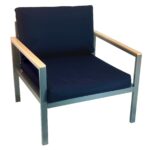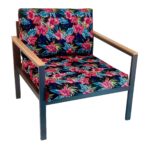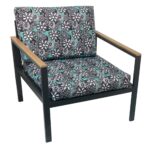How to Protect Outdoor Furniture & Cushions
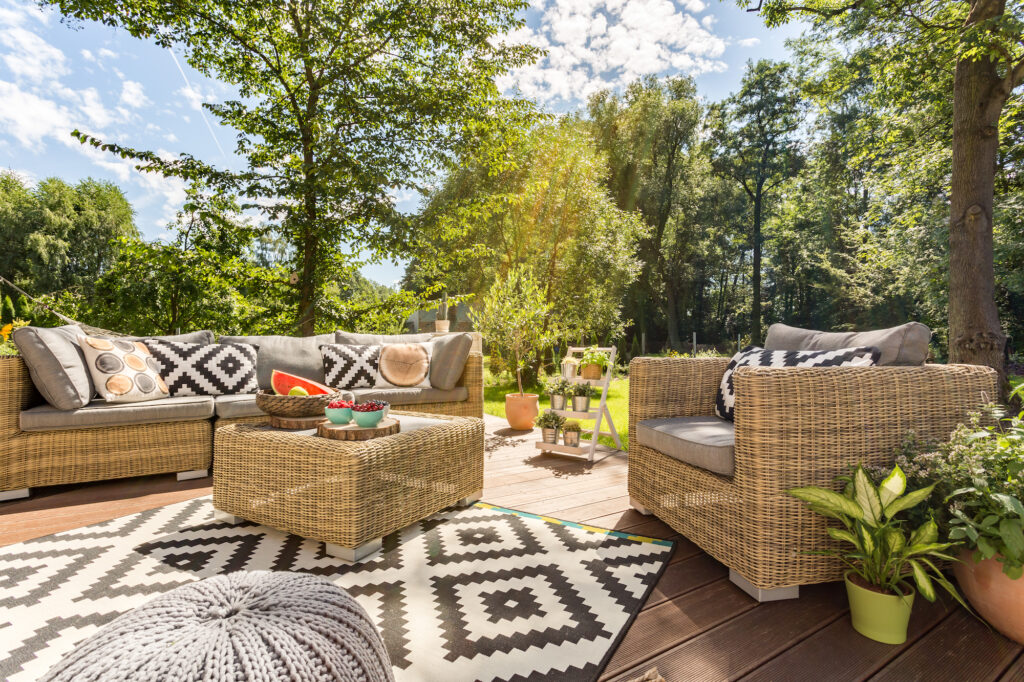
There’s nothing more inviting than clean, comfortable outdoor furniture on a beautiful day.
But figuring out how to protect outdoor furniture, especially outdoor cushions, can feel like a never-ending challenge. In wet conditions, you’re battling rust and mildew. And when the sun finally comes out, you have to worry about harsh sunlight and UV damage.
Without proper protection, your outdoor furniture and cushions will need to be replaced year after year. Not only is that perpetual cycle hard on your wallet, but it’s also hard on the environment. The EPA estimates that 9 million tons of furniture are tossed every single year.
If you’re wondering how to protect outdoor furniture throughout the year and prevent problems like sun damage and mold, you’ve come to the right place! This guide will make maintaining your outdoor furniture and cushions feel like a breeze, no matter the conditions you’re up against.
How to Protect Outdoor Furniture & Cushions Throughout the Year
There are many different approaches to protecting outdoor furniture. The best option for you depends on your budget, the effort you want to put in, and the local climate you’re dealing with. Some patio people choose to invest in high-quality furniture and materials that are designed to withstand their climate. Others cover or store their outdoor furniture during certain times of the year or whenever it’s not in use. Others go head to head against the elements and do everything they can to prevent problems like fading, rust, rot, mold, and mildew.

Choosing the Best Materials for Outdoor Furniture
One of the best ways to prevent problems down the line is to invest in good quality outdoor furniture from the get-go, rather than cheap “fast furniture” (think “fast fashion”) that will end up in a landfill. When choosing outdoor furniture, pay close attention to the materials and fabrics used.
Here are some popular outdoor materials to consider:
Aluminum: lightweight, rust-resistant, and low maintenance with a modern style.
Teak: Durable, weather-resistant, and naturally resistant to rot and insects.
Wrought Iron: Sturdy, heavy-duty, and can withstand high winds.
Resin Wicker: Lightweight and weather-resistant, with a natural look that resembles real wicker.
Stainless Steel: Rust-resistant and low maintenance with a sleek look.
Cedar: Durable and naturally resistant to insects and rot, with a warm and rustic look.
Many of these materials, though highly durable, are not very comfortable on their own. And that’s where outdoor cushions come into play! But what are the best materials for outdoor cushions? Here are the three outdoor fabrics we use for our cushion covers:
Poly-Knit: This fabric is made of polyester and has a knit construction that makes it lightweight, breathable, and durable. It’s resistant to fading, mildew, and water, making it a solid choice for general outdoor use.
Waterproof Polyester: For added protection, choose polyester with a waterproof coating. This type of fabric is typically UV-resistant and easy to clean, so it’s great for outdoor cushions in wetter climates.
Waterproof Canvas: For the ultimate waterproof fabric, we recommend Ottertex® Waterproof Canvas, which we use for our premium waterproof cushion covers. This fabric is treated with a polyurethane solution (PU) backing with a waterproof coating, making it highly durable. It’s then treated with a special coating that makes it resistant to dirt, mildew, and UV rays. Check this other blog post for more information on this versatile fabric.
Investing in better quality materials and fabrics will cost more upfront but save you time, money, and many a headache down the road! But whether you have old patio furniture or brand new furniture, there are additional precautions you can take to prevent damage over time…
How to Prevent Rust
Let’s start with rust— a common problem for outdoor furniture made of metal.
As mentioned above, one way to avoid rust is to choose rust-resistant metals, such as aluminum or stainless steel. Here are a few more ways to prevent rust:
- Apply a rust-resistant coating or wax to your metal furniture
- Use furniture covers when the furniture is not in use or during the rainy season
- Clean and polish metal surfaces regularly to prevent rust buildup
If you already have rust built up, you’ll need to remove it with a wire brush or sandpaper scrub. You can use a rust remover substance or a solution of equal parts white vinegar and water. Once the rust is gone, you can then apply a rust converter, a metal primer, and a coat of paint that is suitable for outdoor use.
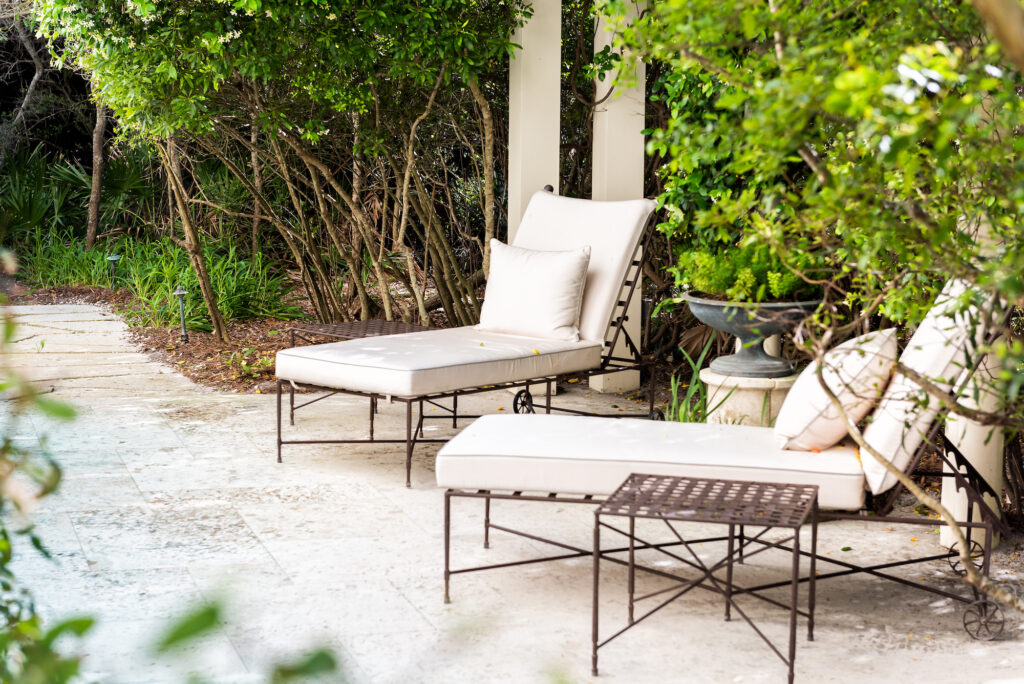
How to Prevent Fabric Fading
Next up, sunlight.
It is no surprise that the sun can damage any fabric. Anyone with a darker color has seen their fabric fade in the sun. If you have ever had one chair in a set that gets direct sunlight all the time while the rest of the set is in the shade, you have seen this difference pretty quickly. The good news is that there are measures you can take and wise color choices that can increase the longevity of your covers.
First of all, color choice is a major component no matter the setup. Darker colors like blacks, reds, and oranges will fade much faster than lighter ones like blues, grays, or tans because of how they absorb photons and UV light. You can also choose certain types of fabric (like Ottertex featured above) that are fade-resistant and come with UV protection.
The best maintenance for your outdoor furniture is placing your set in a shady spot. Using natural foliage, an awning, a covered patio, or umbrellas will increase the lifespan of your patio furniture and cushions. If you have a great shade area, you can use brighter colors and they will last for a very long time. As a bonus, the furniture will also be much more comfortable for you and your guests without the scorching sun beating down on it.
If one of the areas where your furniture is placed gets more sun than the others, rotate, rotate, and rotate! This will minimize the fading and keep it consistent so it won’t be as noticeable. If your furniture does get constant sun, you can get a full patio furniture cover that is typically used for rain and cover them when the patio set is not in use. Or take off your cushions during the hottest part of the day.
How to Prevent Mold & Mildew
Mold is another nightmare for outdoor fabrics, especially in wet, humid climates.
To prevent mold and mildew, regularly clean your outdoor cushions. There are different cleaning methods for different types of fabrics, so check out our guide to cleaning cushions for more specific tips.
To keep the maintenance to a minimum, buy a set of mold-and-mildew-resistant cushion covers to put over your outdoor cushions. Or store your cushions in a dry, well-ventilated area when they aren’t in use.
What to Do About Existing Sun Damage, Wear, & Tear
If it’s too late for prevention and your outdoor cushions are in a state of disrepair, there’s still hope for salvaging them!
Maybe they are faded, fraying at the edges, or stained but otherwise intact and comfortable to sit on. Sure, you could just replace them, but that’s expensive and wasteful.
Rather than replace the entire cushion or patio set, you can just cover them up with a set of removable cushion covers to make them look and feel brand new! This is also a great way to change up the style of your patio furniture if it’s looking a little outdated or tired.
More Tips for Maintaining Outdoor Furniture
In summary, here are some key maintenance tips to help keep your outdoor furniture looking its best throughout the year:
Clean regularly: Clean your outdoor furniture regularly to remove dirt, grime, and stains. Read up on the best type of cleaning solution for the materials you have and avoid using harsh chemicals that can damage the furniture or finish.
Cover or store: During storms, rainy seasons, or other harsh weather, store your patio set in a dry place or cover it with a protective cover.
Apply protective coatings: Depending on the material, you may want to apply a wax, oil, or sealant to protect the furniture from moisture, UV rays, or other environmental factors.
Keep it dry: Wipe down your furniture after the rain and store cushions indoors during the wettest months of the year.
Keep it out of harsh sunlight: Place your patio furniture in the shade whenever possible. Rotate furniture and cushions in partial sunlight to minimize exposure.
Check for damage: Inspect your outdoor furniture regularly for signs of rust, mold, or other damage so you can deal with it promptly and prevent it from worsening.
Invest in durable cushion covers: Cover your outdoor cushions with durable cushion covers made from fade-resistant, mildew-resistant, or waterproof materials.
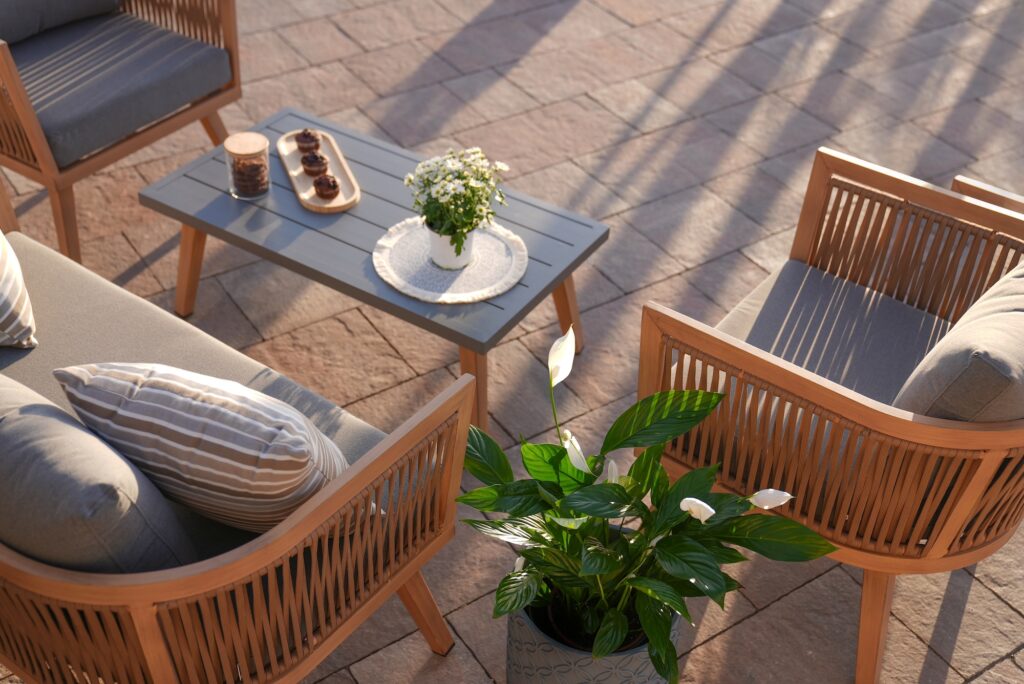
Protect Your Outdoor Cushions with Fig Leaf Cushion Covers!
If properly cared for, your outdoor furniture can last many years, providing you and your loved ones with a comfortable, inviting space to gather and appreciate nature!
If you’re looking to cut down on patio furniture maintenance, Fig Leaf Cushion Covers are a practical, sustainable solution. Our cushion covers, made from high-quality materials, are designed to protect your cushions from the elements and prevent sun damage and water damage. These covers are easy to remove and toss into the wash– perfect for when the inevitable spill happens.
Explore our wide selection of colors, patterns, and fabric options, and let us know if you need any help designing a custom set for your patio furniture!

